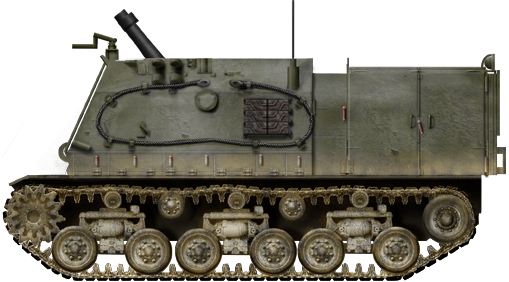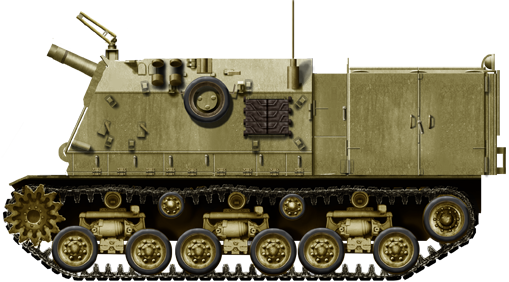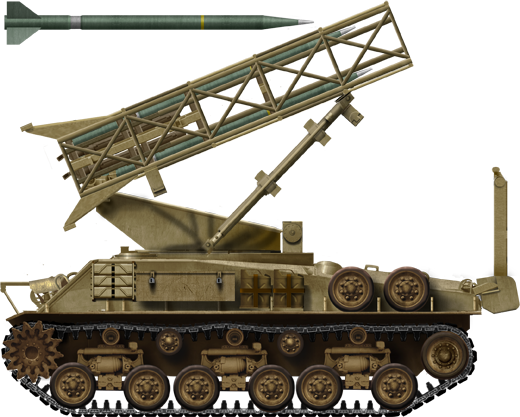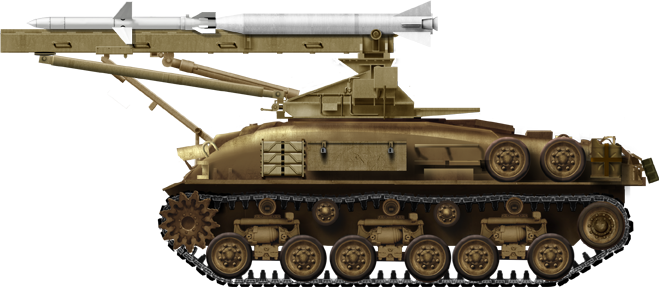The Makmat 160mm Mortar carrier is an Israeli self propelled heavy mortar based on the M4 Sherman chassis, obtained in large numbers in the early years after Israeli independence. This artillery system was used during the 1973 Yom Kippur war and Lebanon campaign to provide fire support but provided limited protection. It was however a way to recycle now obsolete chassis.

Later Krupp Shermans were all re-armed with more M3 guns additional Shermans were purchased from the Philippines, notably M4A4s powered with the Chrysler A57 Multibank replaced by a Continental R-975 radial purchased most likely from France. Then 76mm Sherman variants were acquired in early 1956, the M4A1 (76) W and M4A3 (76) W models and rearmed as "long-barreled" M1 Super Sherman as well as the M50 and M51, taking part in the 1956 Sinai war. By the 1960s however they had reach the end of their usefulness and were vulnerable to the new T-55A and T-62s purchased by neighbouring Arab countries. This was partly solved by the acquisition of Centurions and later M48s which were also transformed over the years (see the Magach lineage) and of course the Merkava. Nevertheless, the M4 variants were still used by Israel during the 1967 and 1973 wars.
No longer useful as frontline tanks, they were still valuable platforms, with engines carefully taken of over decades. Hence started a flurry of conversions: M4 "CRAB" Mine Clearing Tank, early/late types M4 Ambulance, M74 Recovery Vehicle, M4 "LIVE TARGET, the M4 EYAL Observation Tank, the 290mm Rocket Launcher variant and SHERMAN with 75mm AMX-13 Turret, M4 Personnel Carrier and M4 Command Vehicle, 155mm M50 L-33 Ro’em and Golan Self Propelled Artillery Vehicles... and the MakMat.
With political and supply issues Israel always struggled to obtain first grade foreign military kit and had to make due and resort to conversions with what they had, including captured vehicles, such as the T-55 converted Tiran tanks and Achzarit APCs. Later the Centurion and M48 had the same treatment. No chassis was squandered. To start with, there was a bonanza of surplus Shermans after 1973. They had been converted as M50/51s, up-gunned and re-engined to keep relevant and were not worn out as a result in the later 1970s.
As for self propelled guns, IDF started converting the M3 half track in the 1950-60s already as mortar carriers but more firepower and protection was needed. The IDF had the excellent Soltam M-66 160 mm mortar, and proposed to mount it on a heavily modified Sherman. This was approved in 1965 or 1967 already, and the first vehicles appeared in inventory shortly after the 1967 6-days war, in 1968 at the same time as the Ro'Em 155 mm self-propelled howitzer.
To make room for the M-66 mortar, the M50 Degem Bet Sherman’s turret and upper hull were removed completely, down to the lower part of the chassis, where the upper hull met the drivetrain's lower hull. There was a tall and slab-sided welded steel superstructure fitted over the roadwheels arches. This was a casemate tall enough to protect the mortar crew up to helmet level (if semi-standing) and naturally open-topped to fire the large mortar without obstruction.
Very little was used from the M7 self-propelled gun if anything but the location of the bombs racks and other aspects. The latter was indeed used in the IDF, which developed of course the Priest M7 "Roof" covered overhead. The MakMat fighting compartment could be also folded down and serve as a platform for the crew to work around the mortar just like for WW2 German FLAK tanks. But this left the crew completely exposed to counter-battery fire and snipers.
The compartment completely replaced the glacis front and so protection was minimal. The forward panel for example folded down forward, was pierced by a small window with shutter for the driver, seated inside the hull with his torso emerging from the floor hatch. There was also a ladder on the right of the forward plate for front access. Protection is estimated no more than 0.5 inches or 13 mm plating forward and 7 mm or 0.3 inches elswehwere.
The rear chassis had two stowage bins for extra mortar bombs on either side of the engine deck to allow cooling. Access was generally from the rear, well protected betwen the two stowage bins. The intermediate section of the fighting compartment forward had no flat sides, but sloped to artifically increase thickness.
This vehicle/mortar has several advantages including that of not having to be towed since it is itself motorized. Its power linked to its 160mm Soltam mortar launching 38 kg rockets at a distance of approximately 9,500 meters allows it a fairly good firepower despite its relatively questionable precision and left to the skill of the 6 gunners (minimum) who can make up the crew of this amazing machine. The base was the last M50 with its 460 HP engine, with the VVSS late type hydraulic suspensions, rear idler and front sprocket, engine at the back with the transmission tunnel right below the fighting compartment and fuel tanks. The fully equipped Makmat still weighted a hefty 36 tons despite the absence of the whole former upper armour and turret. It measured 3.3m tall or around 3.4 m wide and 6.5 m long.
At the front right was also added a Browning M2 machine gun on a right side pintle (12.7 mm) fed by canvas belts of 110 cartridges. This weapon has a rate of fire of approximately 450 to 550 rounds per minute. The rounds were extracted from the inqide racks, or via doors in-between the rear bins via their top hatch and internal doors. Extra roadhweels and spare tracks were also fastened to the sides for extra protection.
There was room for ready bombs inside, in two racks on either side, about 11 either side, so 22 total. For reloading, they could be passed on by the loader often crouched aft of the fighting compartment, between the bins. But the latter likely carried also the crew's own kits, storage, fuel, oil, tooling and ammunitions for the Browning plus personal weapons. The vehicle had a radio and two whip antennae on the left side. The mortar could be dismounted, although there was little room for the full chassis to be stored anyway.
The M-66 is a 160 mm mortar manufactured by Soltam of Israel. The weapon was based on an earlier 160 mm design, the M-58 mortar by Vammas of Finland. It can fire a 38 kg (84 lb) HE bomb out to a maximum range of 9,600 m and requires a crew of 6-8 to operate. In addition to the towed variant, the M-66 was mounted the Makmat 160 mm adopted in 1968. It is still in depots with IDF. The mortar took most of the internal space and when the panels were closed up, the crew had to take positions and stick to these, as it was really difficult to move inside. The mortar was not fixed but placed on a plate with a traversing crank system, driven by a small handwheel used by a standing operator of the left.
The mortar itself had extra handwheel for fine turning of the traverse and elevation, giving it a 90° angle forward. The mortar weighted from 225–341 kg (496–752 lb) depening on its mount and configuration, with a 6.29 in caliber, +80° elevation and base -20°/+20° mount traverse, added to the 90° vehicle's traverse. Its effective firing range was 9,600 m (10,498 yd) and it came with HE, shrapnel, incendiary or smoke bombs. The mortar could be almost completely folded forward to c30°, resting in an encased support in the forward plate for transport. Generally to fire forward this place was lowered down to avoid blast damage when firing.
The open-topped chassis was however unprotected from counter-battery shell fragments detonating overhead in air-bursts, causing casualties (a reason while the roofed M7 was developed). It saw action in the early operation in Lebanon in 1982, notably "Peace in Galilee", which was likely its last mission. It was withdrawn from service immediately after this last campaign. Indeed by that stage, dedicated M113 versions were adopted, using the same mortar, a more modern, faster and more versatile platform. All M4 variants were on the way out in the late 1980s, many had been preserved to this day, inluding the Makmat, now at the Bar-Yosef museum.

Sherman derivatives in IDF service
The very first Sherman in Israeli Service was an M4A2 already in Palestine, a wreck left behind by retreating British forced seized in a repair depot near the city of Tira, formerly with the Royal Wiltshire Yeomanry, a loss of the Second Battle of El Alamein. Completely repaired it was named “Meir”. Next came "Italian" Shermans, second-hand from the 82nd Tank Battalion and armed with 105mm howitzers but demilitarized with the barrels destroyed. Sent in Haifa by November 1948 they were stripped down for maintenance and later equipped with 50 Krupp field guns purchased from Switzerland in September 1948 with a complicateted conversion which makd them miss the War of Independence. Later three functional 75mm M3 tank guns were purchased from Italy so they could take part in Operation Horev in December 1948 against the Egyptians in the Negev and one nicknamed “Tamar”, abandoned near El Arish.Later Krupp Shermans were all re-armed with more M3 guns additional Shermans were purchased from the Philippines, notably M4A4s powered with the Chrysler A57 Multibank replaced by a Continental R-975 radial purchased most likely from France. Then 76mm Sherman variants were acquired in early 1956, the M4A1 (76) W and M4A3 (76) W models and rearmed as "long-barreled" M1 Super Sherman as well as the M50 and M51, taking part in the 1956 Sinai war. By the 1960s however they had reach the end of their usefulness and were vulnerable to the new T-55A and T-62s purchased by neighbouring Arab countries. This was partly solved by the acquisition of Centurions and later M48s which were also transformed over the years (see the Magach lineage) and of course the Merkava. Nevertheless, the M4 variants were still used by Israel during the 1967 and 1973 wars.
No longer useful as frontline tanks, they were still valuable platforms, with engines carefully taken of over decades. Hence started a flurry of conversions: M4 "CRAB" Mine Clearing Tank, early/late types M4 Ambulance, M74 Recovery Vehicle, M4 "LIVE TARGET, the M4 EYAL Observation Tank, the 290mm Rocket Launcher variant and SHERMAN with 75mm AMX-13 Turret, M4 Personnel Carrier and M4 Command Vehicle, 155mm M50 L-33 Ro’em and Golan Self Propelled Artillery Vehicles... and the MakMat.
Development
Sometimes nicknamed the “toaster tank” in some cicles notably alongside the German Pz.Sfl.IVc. the MakMat was Built on the Sherman chassis with a massive 160 mm mortar inside the original Sherman hull and turret, installed in front of the bulkty radia engine. It was an example of extreme modification to an obsolete vehicle and true exampkle of Israeli's engineers engineering abilities and ingenuity. It was developed in the 1960s to take advantage of the new Israeli M-66 mortar firing 40 kg shell at 9.6 km. That close, it was necessary to have the carrier vehicle protecting its crew.With political and supply issues Israel always struggled to obtain first grade foreign military kit and had to make due and resort to conversions with what they had, including captured vehicles, such as the T-55 converted Tiran tanks and Achzarit APCs. Later the Centurion and M48 had the same treatment. No chassis was squandered. To start with, there was a bonanza of surplus Shermans after 1973. They had been converted as M50/51s, up-gunned and re-engined to keep relevant and were not worn out as a result in the later 1970s.
As for self propelled guns, IDF started converting the M3 half track in the 1950-60s already as mortar carriers but more firepower and protection was needed. The IDF had the excellent Soltam M-66 160 mm mortar, and proposed to mount it on a heavily modified Sherman. This was approved in 1965 or 1967 already, and the first vehicles appeared in inventory shortly after the 1967 6-days war, in 1968 at the same time as the Ro'Em 155 mm self-propelled howitzer.
Design
Conversion

To make room for the M-66 mortar, the M50 Degem Bet Sherman’s turret and upper hull were removed completely, down to the lower part of the chassis, where the upper hull met the drivetrain's lower hull. There was a tall and slab-sided welded steel superstructure fitted over the roadwheels arches. This was a casemate tall enough to protect the mortar crew up to helmet level (if semi-standing) and naturally open-topped to fire the large mortar without obstruction.
Very little was used from the M7 self-propelled gun if anything but the location of the bombs racks and other aspects. The latter was indeed used in the IDF, which developed of course the Priest M7 "Roof" covered overhead. The MakMat fighting compartment could be also folded down and serve as a platform for the crew to work around the mortar just like for WW2 German FLAK tanks. But this left the crew completely exposed to counter-battery fire and snipers.
The compartment completely replaced the glacis front and so protection was minimal. The forward panel for example folded down forward, was pierced by a small window with shutter for the driver, seated inside the hull with his torso emerging from the floor hatch. There was also a ladder on the right of the forward plate for front access. Protection is estimated no more than 0.5 inches or 13 mm plating forward and 7 mm or 0.3 inches elswehwere.
The rear chassis had two stowage bins for extra mortar bombs on either side of the engine deck to allow cooling. Access was generally from the rear, well protected betwen the two stowage bins. The intermediate section of the fighting compartment forward had no flat sides, but sloped to artifically increase thickness.
This vehicle/mortar has several advantages including that of not having to be towed since it is itself motorized. Its power linked to its 160mm Soltam mortar launching 38 kg rockets at a distance of approximately 9,500 meters allows it a fairly good firepower despite its relatively questionable precision and left to the skill of the 6 gunners (minimum) who can make up the crew of this amazing machine. The base was the last M50 with its 460 HP engine, with the VVSS late type hydraulic suspensions, rear idler and front sprocket, engine at the back with the transmission tunnel right below the fighting compartment and fuel tanks. The fully equipped Makmat still weighted a hefty 36 tons despite the absence of the whole former upper armour and turret. It measured 3.3m tall or around 3.4 m wide and 6.5 m long.
At the front right was also added a Browning M2 machine gun on a right side pintle (12.7 mm) fed by canvas belts of 110 cartridges. This weapon has a rate of fire of approximately 450 to 550 rounds per minute. The rounds were extracted from the inqide racks, or via doors in-between the rear bins via their top hatch and internal doors. Extra roadhweels and spare tracks were also fastened to the sides for extra protection.
There was room for ready bombs inside, in two racks on either side, about 11 either side, so 22 total. For reloading, they could be passed on by the loader often crouched aft of the fighting compartment, between the bins. But the latter likely carried also the crew's own kits, storage, fuel, oil, tooling and ammunitions for the Browning plus personal weapons. The vehicle had a radio and two whip antennae on the left side. The mortar could be dismounted, although there was little room for the full chassis to be stored anyway.
Soltam M66 Mortar

The M-66 is a 160 mm mortar manufactured by Soltam of Israel. The weapon was based on an earlier 160 mm design, the M-58 mortar by Vammas of Finland. It can fire a 38 kg (84 lb) HE bomb out to a maximum range of 9,600 m and requires a crew of 6-8 to operate. In addition to the towed variant, the M-66 was mounted the Makmat 160 mm adopted in 1968. It is still in depots with IDF. The mortar took most of the internal space and when the panels were closed up, the crew had to take positions and stick to these, as it was really difficult to move inside. The mortar was not fixed but placed on a plate with a traversing crank system, driven by a small handwheel used by a standing operator of the left.
The mortar itself had extra handwheel for fine turning of the traverse and elevation, giving it a 90° angle forward. The mortar weighted from 225–341 kg (496–752 lb) depening on its mount and configuration, with a 6.29 in caliber, +80° elevation and base -20°/+20° mount traverse, added to the 90° vehicle's traverse. Its effective firing range was 9,600 m (10,498 yd) and it came with HE, shrapnel, incendiary or smoke bombs. The mortar could be almost completely folded forward to c30°, resting in an encased support in the forward plate for transport. Generally to fire forward this place was lowered down to avoid blast damage when firing.
Combat
According to most sources, it seems that some 150 MakMat 160 mm self-propelled mortars had been manufactured up 1974-75. It was never offered for export, even as a conversion for countries posessing the Sherman probably due to the cost of such conversion in the first place. The M-66 mortar was however largely exported and stays in service today. The MakMat was prominently and widely used during the Yom Kippur War in 1973. It was particularly effective when used for battlefield illumination. It soon found its place, grouped into batteries of four organic to various infantry units, capable of delivering quick fire support and avoid counter-battery fire due to its superior mobility unlike the standard towed M66 mortar.The open-topped chassis was however unprotected from counter-battery shell fragments detonating overhead in air-bursts, causing casualties (a reason while the roofed M7 was developed). It saw action in the early operation in Lebanon in 1982, notably "Peace in Galilee", which was likely its last mission. It was withdrawn from service immediately after this last campaign. Indeed by that stage, dedicated M113 versions were adopted, using the same mortar, a more modern, faster and more versatile platform. All M4 variants were on the way out in the late 1980s, many had been preserved to this day, inluding the Makmat, now at the Bar-Yosef museum.

New 160mm MakMat in the Sinai, 1975. Note the mortar in resting position for transport.

160mm MakMat used on Lebanon in nothern olive livery, pretty worn out 1985

Another variant, the 290 mm M50 Haviv rocket launcher

Another variant, the M50 AGM-45 SAM Launcher
MakMat specifications | |
| Dimensions (l-w-h): | 6.5 x 3.4 x 3.3m est. |
| Total weight, battle ready: | 36 Tons |
| Crew : | Min. 6 (Driver, Commander, 1-2 Gunners, 3-4 loaders) |
| Propulsion: | Cummins VT-8 Diesel 460 hp |
| Suspensions: | Vertical Volute Springs (VVSS) |
| Top Speed | 65 kph (40 mph) 40-45 kph off-road |
| Range (road)/Fuel consumption | 600 km (372 mi) |
| Armament (see notes) | 3 x 7,62 mm (0.3 in) LMGs (including one Rafael remote station) |
| Armour | Lower hull: Same as M50, upper compartment: Max 0.5 in |
| Total Production | c150 1979 |
Links
D.Eschel - Chariots in the DesertT.Gannon - Israeli Sherman
R.P.Hunnicutt - Sherman (A History of the American Medium Tank)
Warmachines No. 4 - Israeli M4 Sherman and Derivatives, Francois Verlinden
warfarehistorynetwork.com shermans in IDF service
armedconflicts.com
pmulcahy.com IDF mortar carriers
israeli-weapons.com
M50 super sherman on TE
tankhistoria.com
tsahal-miniature.com Makmat
israeli-weapons.com (archive)
tsahal-miniature.com, sherman variants
sherman minutia


Cold War Tanks


































Cold war tanks posters

Cold War Main Battle Tanks

Cold War Soviet Army
Museums, Movies, Books & Games
The Tanks and Armor in pop culture
Tanks and armored vehicles in general are only really grasped when seen first person: The mass, the scale, it's all there. Explore also the way tanks were covered in the movie industry, in books and in video games.Movies:
Best tanks movie on warhistoryonline.com
On imdb.com
On bestsimilar.com/
miltours.com
liveabout.com/
watchmojo.com
Video Games:
pcgamesn.com
historyhit.com
levvvel.com
vg247.com/best-tank-games
mmobomb.com/
alienwarearena.com

